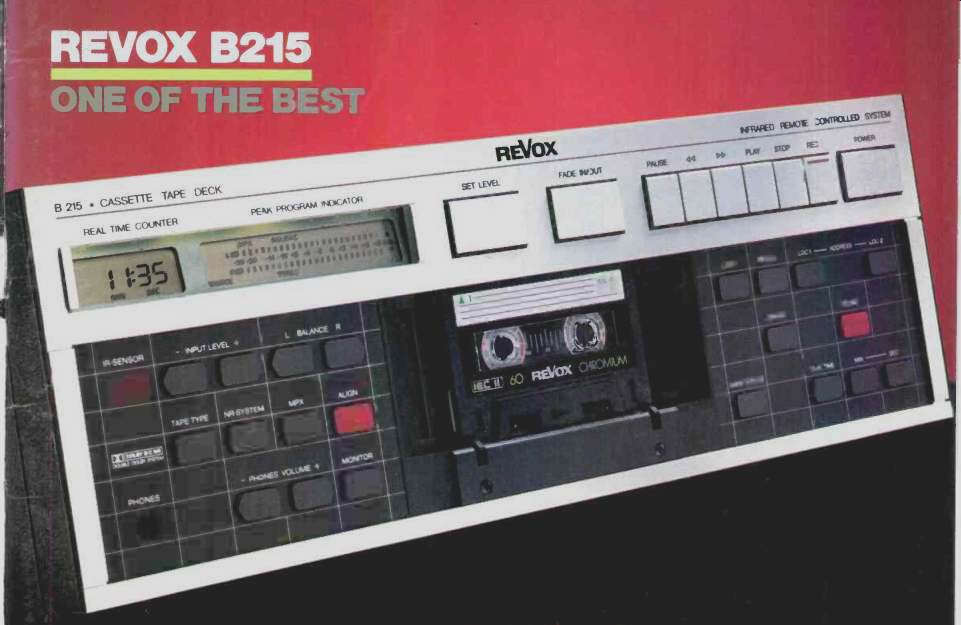
Manufacturer's Specifications:
Frequency Response: 30 Hz to 18: kHz; to 20 kHz with CrO2 and metal tapes.
Harmonic Distortion: 0.8%.
Signal/Noise Ratio: 72 dBA with Dolby C NR.
Separation: 40 dB.
Erasure: 70 dB.
Input Sensitivity: 50 mV.
Output Level: Line, 775 mV; headphone, 2.8 V.
Flutter: ± 0.1% wtd. peak.
Fast-Wind Time: 75 S for C-90 cassette.
Dimensions: 17.7 in. W x 6 in. H x 13.1 in. D (45 cm x 15 cm x 33 cm).
Weight: 20.4 lbs. (9.2 kg).
Price: $1,400; B205 remote-control transmitter, $125.

Company Address: 1425 Elm Hill Pike, Nashville, Tenn. 37210, USA.
The Revox B215 cassette deck uses sophisticated micro processing for many internal functions. There are actually three microprocessors: One for the time counter, another for the automatic tape-matching system, and the third for housekeeping and for control interfacing with other components in Revox's B200 series.
All units in this series can be operated from the same optional remote-control unit. But they can also connect, via rear-panel serial ports, to a separate interface box which can then be connected to a home computer (for programmed control) or to infrared remote-control receivers in other rooms. With the Revox units interconnected in this way, one could simultaneously start the 8215 tape deck and switch the receiver to "Tape" mode by pressing "Play" on the remote transmitter-whether the transmitter is pointed at the receiver, the B215, the interface unit, or an infrared receiver in another room.
The most important use for the on-board microprocessing is the automatic alignment to match the characteristics of any tape used. In just 20 S, adjustments are made automatically to bias, record sensitivity and equalization to ensure flat response, good Dolby NR tracking and low distortion.
Information on the internal settings can be stored for two Type I tapes, three Type IIs, and one Type IV. The B215 also incorporates the Dolby HX Professional system, which varies bias during recording in accordance with the spectral makeup of the signal for lowest distortion overall.
The microprocessor-controlled time counter yields elapsed-time indications after only a few seconds of play, no matter where the cassette is started. A selected elapsed time can be entered, and a fast-wind made to that point.
Two time addresses can be stored for one-button fast-wind returns, or for looping (continuous play) between them.
Another helpful feature of the B215 is a system which automatically sets recording levels. Automatic fade-in and fade-out during recording is an additional nicety.
The tape drive uses four motors, two for the direct-drive capstans and two for spooling the tape. An optical end-of tape sensor stops the transport at the start of the clear leader, instead of at its end. This positions the tape exactly where recording can be restarted as soon as the cassette is flipped; time is not lost while the leader passes the heads once in each direction.
Control Layout
The B215 deck is large, but it has a friendly look, with brushed aluminum as the top of the front panel and dark gray for the lower part. The black designations on top and the white ones below are very easy to read over a wide range of lighting levels, making the B215 one of the best units in this regard. The very large, aluminum pushbuttons and the large, medium-gray and red ones all stand out clearly from the panel and require just a light touch for actuation.
After the deck is plugged in but before it is turned on, a red standby indicator illuminates in the "IR-Sensor" window at the upper left end of the gray panel. The deck can be turned on in either of two ways, with the B205 remote control or with the "Power" pushbutton at the upper right of the front panel. With turn-on, the red indicator goes off, and the "Real
Time Counter" and "Peak Program Indicator" LCDs appear.
The counter display shows "--:--" over "Min" and "Sec" to remind the user that calibration has not been done for an elapsed-time indication. The "Peak Program Indicator" has "L" and "R" horizontal meter scales and calibrations from " 30" to " + 8" in between. Just to the right of the meters is "Bal" with an arrow above it, pointing up (next to the "L" scale), and an arrow below it, pointing down (next to the "R" scale). At the lower left of the same display area, "Source" announces that the incoming signal is being monitored.
Additional details of these displays will be given while discussing the use of the pushbuttons.
To the right of the displays are the "Set Level" and "Fade In/Out" pushbuttons. "Se: Level" automatically sets the digitally controlled input-level attenuator while you play the loudest portion of a disc, so that the highest recording levels will be just below the point where unacceptable distortion would occur. Automatic setting continues as long as the button is held in, so the actual time taken is determined by the user.
With the "Fade In/Out" button, the signal can be faded between full off and the preset attenuator level, whenever desired. You cannot, however, vary the fade speed or interrupt the fade halfway. Fades can be made any time during recording without stopping the transport.
Fading is also invoked by the "Pause" control, which is grouped, with the other transport-control buttons, to the fade button's right. There is an automatic fade-in if recording is started from record-pause mode (rather than "Stop"), and an automatic fade-out if you interrupt recording with the "Pause" instead of the "Stop" button. Pressing "Pause" also automatically switches the monitoring back to "Source," in anticipation of continued recording-a convenient feature.
It is possible to switch among modes as desired, and punch-in recording is possible by holding "Rec" and "Play" at the same time. The above constitute a nice collection of features for the serious recordist.
In "Rec/Pause," the meter display shows "Source" and, above, a flashing "Record." Pushing "Pause" again initiates recording, with the display indicating the change in monitor status from "Source" to "Tape." Below the transport buttons are nine gray pushbuttons plus the "Store" button, which is red. The top row consists of " Loop," "Recall," and two "Address" buttons, "Loc 1" and "Loc 2." The next row is for "Cancel" and the aforementioned "Store." The bottom row has "Save Status," "Play Time," "Min," and "Sec." When a cassette is first inserted, "Real Time Counter" is blank, as mentioned earlier. With a push of "Play Time," a standard tape length (whichever you used last) will be displayed; successive pushes will step the indicated length from "C 46" to 'IC 60" to "C 90" to "C 120," and back to the start again. After the selection of the correct length, a few seconds of playing or recording will get a calibrated, elapsed-time reading in the counter display. After calibration has been completed, a start of recording will automatically store the "Min/Sec" address (tape location) in "Loc 1." By use of the "Min," "Sec" and "Store" buttons, and then "Loc 1" or "Loc 2," any location on the tape can be put in memory. Except when in record mode, a push of "Loc 1" or "Loc 2" will initiate a fast-wind to that exact point on the tape. The counter display shows "Loc" and "1" and/or "2" above it when there is an entry or two to indicate. When both locations are used, a push of " Loop" will initiate continuous play and rewind cycling between the two points, even fast winding to the start point from any location on the tape.
Arrows appear between the tops and bottoms of the "1" and "2" in the display, reminding the user that the deck is in " Loop" mode. "Recall" and a location button will get a display of the corresponding tape-time location. "Cancel" will, of course, clear the memory of whichever button is pushed.
"Save Status" is used to store all recorder settings including level, NR system, balance, etc., in a nonvolatile memory for use with a timer (which, of course, shuts off all power to the recorder for a period of time).
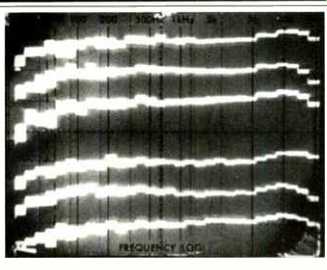
Fig. 1--Record/playback responses using Dolby C NR. Top three traces made with
Maxell UD-XL I (Type I), TDK HX-S (Type II) and TDK MA-R (Type IV), all at
Dolby level. Bottom three traces with the same tapes but at -20 dB. (Scale:
5 dB/div.)

Fig. 2--Record/playback responses. Upper four traces, all made with Dolby
C NR, are: +6 dB on Maxell UD-XL I, +4 dB on TDK HX-S, +6 dB on TDK MA-R,
and +10 dB on Maxell UD-XL I. Bottom trace shows overlaid responses with
Dolby B and C NR and without NR, all made on UD-XL I tape at-14 dB. (Scale:
5 dB/div.)
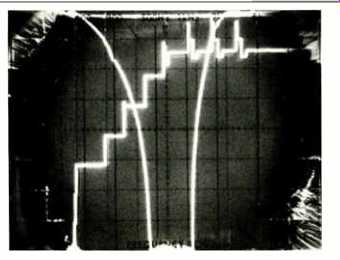
Fig. 3--Tests of two gain adjustment functions.
Curved trace shows fade-out from 0 dB to maximum attenuation, and fade-in from maximum attenuation to 0 dB. Stepped trace shows action of "Set Level" function as input is increased in 10-dB steps from-70 to 0 dB (see text). (Vertical scale: 10 dB/div.; horizontal scales, 1 S/div. for fader, 5 S/div. for "Set Level" test.)
Under the counter and meter displays are 11 pushbuttons, 10 gray and one red. The top row, just to the right of the infrared sensor mentioned earlier, has two buttons for input level ("-" and "+") and two for balance ("L" and "R"). When an input-level button is held in, a relative level from "-00" to "+ 10" appears in place of the "Min/Sec" readout. A brief push will get single steps up or down, and a hold will obtain continuous stepping which increases in speed as the button is held in. The arrows above and below "Bal" show when there is electrical balance, but the level indication must be used to find the best setting.
The second row of buttons under the displays consists of "Tape Type," "NR System," "MPX," and the red "Align." When a cassette is first inserted into the holder, tape type is automatically sensed and displayed, provided that the cassette has the sensing holes which indicate this information.
"Tape Type" allows manual setting for "Type I," "Type II," "Type 11-120 µS," and "Type IV." All are self-explanatory with the exception of "Type II-120 µS." This is an unusual and useful feature for the serious recordist: If there is a more-than-average amount of energy in the higher frequencies, the results with a Type II tape may be better with 120-µS EO instead of the usual 70 µS. The selected tape type is announced along the bottom of the meter display, Type I to Type IV, left to right.
The selection of "MPX," "Dolby B," or "Dolby C" is similarly indicated along the top of the meter display. "MPX" is an on/off selection, and "NR System" steps the choice from off to "Dolby B" to "Dolby C" NR. Alignment, in the case of the Revox B215, means electronic adjustment of the recording function and not the mechanical adjustment of a record or playback head. A push of "Align" with the deck in record/pause mode starts the process that adjusts bias, record sensitivity and equalization for the best responses with low distortion, both with and without Dolby NR. It's a 20-S procedure, and while it's functioning, "Align" appears at the lower right in the meter display. There are a total of six memory locations for alignment information: Two for Type I tapes (A1 and A2), three for Type II (A1, A2, A3), and one for Type IV (A1). With the use of "Align," the settings are automatically put into memory, normally A1 location. To save the settings for another tape formulation without disturbing the information in memory A1, push "Align" and then the "Pause" button to step to the next memory location. Overall, this is a very good way to handle tape matching, with the convenience of storing the matching-condition information for the tapes most used. These memories are also nonvolatile, holding their contents even if the recorder's power is disconnected.
Along the bottom row of buttons below the display are the headphone jack, all the way to the left, two "Phones Volume" buttons ("-/+") and the "Monitor" selector (causing "Source" or "Tape" to appear in the meter display). The headphone level can be set to one of eight steps. My immediate reaction to this design was a bit of skepticism, but I reserved judgment until I actually tried listening.
The shallow, vertical well for the cassette has a very open design, which gives outstanding access for any sort of cleaning or demagnetizing. Inserting a cassette was a simple process of putting the top in first, then pushing in the bottom. I liked the finish and the ruggedness of the drive elements, particularly the large diameter of the capstan shafts.
On the B215's back panel are the expected stereo pairs of in/out phono jacks. There is also a DIN-type socket for the serial interconnection link with other Revox equipment. The power cord is detachable.
Removing the steel top and back covers allowed examination of the interior. The chassis has a rigid, box-girder construction, providing excellent support for the transport system and the circuit cards. The large flywheels were very evident, and the rest of the drive was judged to be very well constructed, with a definite look of long-term reliability. The drive was very quiet, even in play mode-perhaps the quietest of any deck I've tested to date. The soldering on the cards was excellent, with slight flux at a few hand-soldered points. There were a total of four fuses, all in clips.
Measurements
The playback responses of the Revox B215 were the best I have measured to date, with many points within ±0.3 dB of the reference level. Playback of a standard flux level was indicated correctly, and tape play speed was 0.2% fast, at the most.
For record/playback measurements, I used "Align" to match the deck to a large number of tapes having a wide range of bias and sensitivity characteristics. For the test signal. I used what I call "PN/Music"--pink noise rolled off at 2 kHz-to ensure accurate assessment of the performance with Dolby C NR. (Testing with sine-wave signals can give a misleading impression of response irregularities with Dolby C NR.) The record/playback responses were at least very good with every tape tried, and excellent with most. Maxell UD-XL I, and TDK HX-S and MA-R, were judged to be the best overall and were therefore used for the detailed tests that followed. Excellent results were also obtained with these Type I tapes: BASF Pro I Super, Fuji FR-I, Maxell XL I-S, PDMagnetics Tri-Oxide Ferro HG, Sony AHF, TDK AD and AD-X, and Yamaha NR-X. Type II tapes with excellent results included BASF Pro II Chrome, Fuji FR-II, Maxell UD-XL II and XL II-S, PDMagnetics 500 Crolyn HG, Sony UCX and UCX-S, TDK SA-X, and Yamaha CR. Among Type IV tapes, Maxell MX, Memorex Metal IV, Sony Metallic, TDK MA, and Yamaha MR were excellent. I was further impressed by the fact that the B215 got very good responses with BASF Metal IV in the C-120 length, much better than other decks I have tried.
Revox did not provide detailed information on the alignment process, but a little detective work with the aid of my Hewlett-Packard computing counter got these clues: There is a sequence of four tones-17.4 kHz, 477 Hz, 17.4 kHz, and 3.7 kHz-with many stepped-level changes in the first three tones and a relatively small and smooth change in the level of the final tone. The deck's output was muted during "Align," but it was possible to observe the sequence with playback later. There were many changes during the 20-S process, and I could see that there were many comparisons made between 477-Hz and 17.4-kHz outputs at a number of absolute levels. It appeared more than likely that settings for bias and record sensitivity were very accurately set for good responses and low distortion. The 3.7-kHz level adjustment was judged to be the final touch-up for the flattest responses across the band.
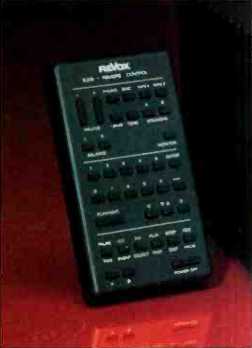
above: Because it also controls other Revox components, the B205 remote unit has more buttons than the B215 tape deck.
Figure 1 shows record/playback responses, with Dolby C NR, for the three selected tapes, both at Dolby level and 20 dB below that. All of the responses are very flat, including those at 0 dB. (I should point out that with the PN/Music test signal, there will be less high-end roll-off in the playback because the rolled-off test signal causes much less tape saturation.) Having made that parenthetical note, I call attention to Table I, which lists the-3 dB limits for all three tapes, with and without Dolby C NR. These tests were made with sine-wave test tones which were not rolled off at the higher frequencies. The results were outstanding at Dolby level: The low-end responses dipped down 3 dB at 22 to 24 Hz, came back up somewhat, and finally rolled off at 9.4 to 10.4 Hz. Figure 2 shows record/playback responses with PN/Music at higher levels. The outstanding Dolby NR tracking is illustrated in the bottom trace, where the results at -14 dB for no NR, Dolby B and Dolby C NR are all overlaid, making just one trace.
Table II lists a number of measured record/playback characteristics, all excellent. The measurement for 10-kHz phase error and jitter between channels was one of the best I have ever seen, and the multiplex filter was positioned exactly. The level of bias in the output during recording was very low.
The level of the third-harmonic distortion (HDL3) was measured, with Dolby C NR, as a function of level for the three apes, and as a function of frequency at-10 dB with TDK HX-S tape. Table Ill lists the distortion in the output from -10 dB to the points where HDL3 equals 3%. The distortion limit levels are somewhat low, but the distortion figures for 0 dB correspond very closely to specifications. The mid-band distortion was not as low as some other decks' (Table IV), but 0.24% at the frequency extremes is very good.
Signal/noise ratios were measured with and without Dolby C NR, with both IEC A and CCIR/ARM weightings. The results in Table V are a close match to other high-performance decks at Dolby level, but are somewhat low with reference to the 3% limit point. This does, of course, correlate to the somewhat low 3% points measured earlier. Perhaps we should recall the deck's outstanding frequency responses to remind us of the trade-offs involved in recorder design.
Table VI shows measurements obtained for a number of input/output properties. Everything seemed quite in order, but the overload level of 2.65 V calls for caution on the part of users who might feed the deck from equipment whose output capability is greater than this.
Figure 3 shows time and level plots of "Fade In/Out" and "Set Level." The sweep rate for the fades is 1 S/div. The fade-out takes about 2.4 S and the fade-in a little over 1 S, both acceptable times.
To test the "Set Level" function, I first attenuated the output from my test generator by 70 dB and set the B215's input level control to "-00" to challenge the automatic function with an extremely low-level test signal. The B215 automatically and rapidly readjusted its input attenuator to its maximum setting, "+ 10," but, as Fig. 3 shows, the resulting record level was still only 35 dB. I then increased the test generator's output in 10-dB steps. For the changes from-70 to-40 dB of generator output, the B215's attenuator remained at "+ 10," and recording level rose in accordance with the input-level changes. When the generator's output reached-30 dB, recorded level shot past its final limit, dropped briefly, then settled at the desired recording level, and the B215's attenuator reset itself to "+8." The action on subsequent 10-dB jumps in generator output was the same-a sharp rise, two sharp drops, and a final adjustment. The attenuator readout reflected these changes: "-2," "-12," and "-22." The B215 set its recording level below the distortion limit on these final four input-level steps. Because of its obvious stepping, "Set Level" should not be used during actual final recording, but it is a great convenience for setting up.
The input-level pushbuttons were used to make the deck's input attenuator step from maximum (+ 10) down to no. There were 1-dB steps from + 10 to-44, followed by 46,-48,-51,-54,-60, and finally-Do. Each of the steps was substantially without error, and the tracking between sections was within 0.1 dB from + 10 down to 54.
These results are much superior to anything else that I have checked in the past.
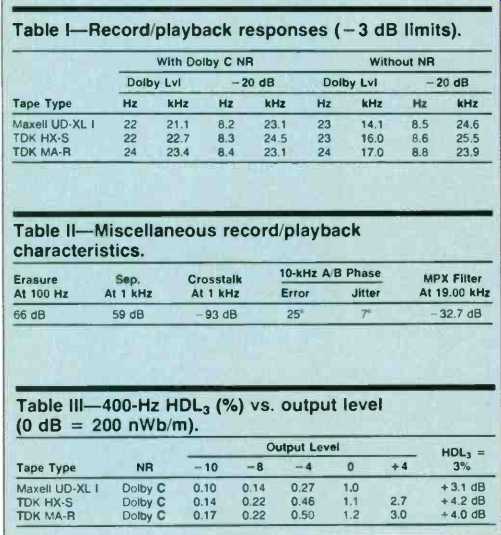
Table I-Record/playback responses (-3 dB limits).
Table II-Miscellaneous record/playback characteristics.
Table III-400-Hz HDL3 (%) vs. output level (0 dB = 200 nWb/m).
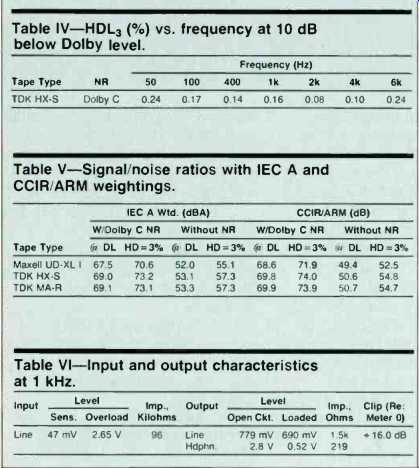
Table IV--HDL3 (%) vs. frequency at 10 dB below Dolby level.
Table V--Signal/noise ratios with IEC A and CCIR/ARM weightings.
Table VI--Input and output characteristics at 1 kHz.
There are eight positions for balance on either side of zero. The first "L" step, for example, increases "L" level by 1 dB; the second "L" step decreases the "R" level by 1 dB; the third step increases the "L" level by another dB, etc., until, with the eighth step, "L" has been increased by 4 dB and "R" has been decreased 4 dB. It is an interesting way of balancing, and it could be the best way, at that.
The headphone volume adjustments were measured as: Maximum (0 dB),-4.1,-9.2,-14.2,-20.2,-28.1, -38.6 dB, and off. My first reaction was that the steps were too coarse, but trials revealed that the changes seemed quite right for whatever the user might desire-"a little softer," for example. I tried a number of headphones and found there was enough gain to drive any of them to very high levels.
Tracking between channels was outstanding, so there was no need for balance trimming. The deck's output polarity was inverted in "Tape" but not in "Source" output mode.
Each of the horizontal bar-graph meter sections has 24 separate segments, although the bottom one in each meter is always on. Scaling extends from "-30" to "+8," with the lowest figures somewhat out of calibration. Accuracy was good from " 18" to " 6," however, and the single-dB steps from "-5" to "+8" were all within 0.1 dB-superb over this important recording-level range. The dynamic responses of the meters met the requirements of the standard for peak program meters, with response to 1 dB with a 10mS tone burst and a 1.4-S decay time. There were slightly higher meter indications with the tone-burst offset, but there should have been more of a change. The frequency response of the meters was down 3 dB at 7.0 Hz and 169 kHz; the latter appears to be unnecessarily high.
Substantially no changes in tape play speed were detected with changes in line power from 110 to 130 V. Short-term variations in play speed were less than ± 0.01%, excellent indeed. The flutter was marvelously low and very consistent throughout the length of a C-90, 0.010% wtd. rms and ± 0.023% wtd. peak. After checking the effect of changing modes and loading and unloading the tape, I concluded that the B215 showed the best overall flutter performance I have measured to date.
The fast-wind speed was high, just 73 S for a C-90, but the stops were smooth and gentle. Times required for changing modes were very short, really too short to measure with a stopwatch. Cueing with fast-forward or rewind and "Stop" worked well, and seemed quite natural after a few trials. Calibration of the elapsed-time counter took about 7 S. With calibration made at the start of a cassette, errors built up during the playing, totaling a minute or so halfway through a C-90. Recalibration at that point reduced the error to several seconds, which is very acceptable. This is a good feature, but I would expect better accuracy. In case of any question, it would appear best to recalibrate the counter halfway through.
Use and Listening Tests
The owner's manual has a very good (albeit un-detailed) text, well organized, with helpful illustrations. Technical freaks would probably like more information on "Align" and the use of the microprocessors. The manual does not mention that punch-in recording is possible. Brief use pointed out to me that a cassette had to be advanced at least a short distance for 'Align" to work; that was easy to do, and the benefits were great.
No record clicks could be detected by ear or meter, even when using Dolby C NR. There were very soft pause and stop "clunks" down in the tape noise (no indication on the monitoring meter). I found that with "Stop," and more so with "Pause," very short sections of the tape being used were not erased completely-leaving little beeps from my earlier tests. A very short rewind would be in order to prevent such distractions if a tape is being reused and has not been bulk erased.
For record/playback listening tests, I used pink noise for tracking tests and dbx-encoded disc versions of digitally recorded originals: Wolftracks with John Kay and Steppenwolf (Nautilus NR-53/dbx PS-1084), music of Rodrigo (Varese Sarabande VCDM 1000.150/dbx PS-1032), and others.
The results were excellent. aided. I am sure, by the peak responding meters, which were easy to read over a fairly wide range of illumination levels. With recording levels set quite high, I did prefer the Type II results over Type I, and the Type IV results over Type II; in each of these successive comparisons, the bass became less muddy and the music better detailed. Once again, I concluded that, with listening at high levels, the maximum recording level was best kept to that for a distortion of about 1% -- about 0 dB on the B215.
The Revox B215 utilizes its microprocessors for many important and helpful things. "Align" performed very well, and the responses were among the best seen to date.
Flutter performance was superlative, and the construction of the transport was judged to offer long-term reliability. The B215 is large, so it won't fit just anyplace, but it should have considerable attraction for those who seek performance and advanced features.
-Howard A. Roberson
( Audio magazine, Jul. 1985)
Also see:
Revox B710 MKII Cassette Deck (Mar. 1983)
Revox B225 Compact Disc Player (Sept. 1984)
Revox B215 cassette deck (Jan. 1987)
= = = =